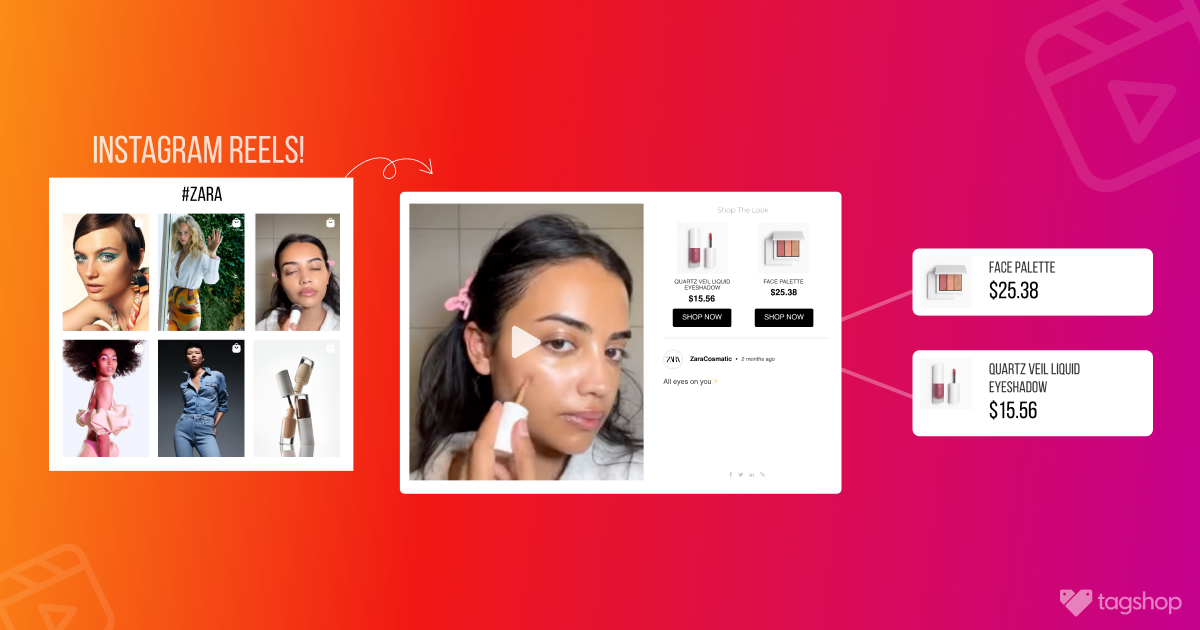30 Ecommerce Conversion Rate Optimization Strategies For 2025
Ecommerce conversion rate optimization has become a necessity for eCommerce & online brands in the present age.
The online shopping market is growing exponentially with its easy-to-use, universally accessible, diverse, and interactive aesthetics.
Even experiential elements are also being integrated into eCommerce, just like offline brick-and-mortar shops.
Although the eCommerce market is expanding rapidly as an eCommerce or online store, you need to be vigilant about your ecommerce conversion rate optimization strategies & actions – even if you are an experienced player in the market – as one wrong action can lead to enormous losses.
We have formulated this complete expert guide for eCommerce brands & online stores to optimize and improve eCommerce conversion rate, including expert conversion rate optimization strategies & best eCommerce conversion tools.
Let us first understand the basics!
What is eCommerce Conversion Rate?
The eCommerce conversion rate is defined by the total number of sales (conversions) divided by the total number of visitors in a defined period on an eCommerce platform or online store.
To understand more specifically, an eCommerce conversion can be any of the following:
- A sale of a product/services
- Signup by a user on the eCommerce platform
- Add products to cart or Wishlist
- A user took any specific action on the eCommerce platform (predefined as a KPI)
The theory of having maximum traffic increases the possibilities to increase the eCommerce conversion rate. But that is not always true. Countless factors affect the journey of a visit to conversion.
We have brought together the complete guide about eCommerce conversion rate optimization issues, reasons, benchmarks, and most importantly, eCommerce conversion optimization strategies.
eCommerce conversion rate optimization is the process of implementing strategies & taking actions on eCommerce store to maximize conversions & improve the user shopping experience
30 Ecommerce Conversion Rate Optimization Strategies
We have listed 30 key eCommerce conversion rate optimization strategies for online brands. These strategies have been identified and brought together after comprehensive research and analysis for eCommerce conversion optimization.
1. Understanding Consumer Behavior Is Most Important
Before forming any strategy or action plan for your eCommerce business, you need to know your target audience, interests, demographic data, geographics, persisting consumer trends & their online behavior.
Having an ideal buyer persona will help you determine what the audience expects from you as an eCommerce, and then you can optimize your strategy and eCommerce platform accordingly.
To gain insights into consumer behavior, you can use cookies, analytics tools, social media monitoring, etc. Google Analytics is one example that provides you with data like sentiments, the correlation among online user actions, demographics & much more for eCommerce conversion optimization.
The more complex the eCommerce business, the harder it is to track which data is collected and stored. After that, automating the detection, categorizing, and searching process with data discovery tools is crucial. Google Analytics is a tool that provides a wealth of information for optimizing eCommerce conversions, including data on user sentiment, correlations between online actions, and demographic information.
2. Easy Product Discovery & Store Navigation
Product discovery is one of the major influencers of low engagement and high bounce rates for an eCommerce store. What can be more irritating than if a user comes to your eCommerce store and cannot find the product he wants and have it on your eCommerce?
If the user discovers the product or navigates through your online store, you will lose earned users who intended to explore and probably buy the product.
Ensure that your website is well-structured with limited and necessary categories to avoid unnecessary confusion. Incorporate filters for the customers to sort by size, color, etc., to offer a more seamless and quick shopping experience.
3. Embrace The Power of “Shoppable UGC”
Shoppable UGC or Shoppable User-generated content can be termed the most influential strategy for eCommerce for 2025.
User-generated content is the most trustworthy, reliable, and authentic form of content that inspires users to get inspiration and build the intent to buy the showcased products in the UGC.
UGC is extremely helpful in shaping a consumer’s online shopping decision, and 90% of consumers agree with it.UGC is extremely helpful in shaping a consumer’s online shopping decision, and 90% of consumers agree with it.
You can collect such UGC from social media platforms and tag products to make them shoppable and publish shoppable UGC galleries on websites. Tagshop is the perfect tool that can help you leverage Shoppable UGC for your eCommerce conversion rate optimization. Similarly, you can also publish shoppable Instagram galleries.
4. Leverage High-Quality Images & Videos
Consider this: Your shoppers cannot see the product in person. Instead, they are making the decision online.
You must ensure that your customers can relate to the product and feel the need to purchase it. This is why you must ensure that the pictures and videos displaying the product’s use case are high quality. If you compromise on this aspect, you may lose your customers!

5. Highlight The Sales Section
Let’s admit it! All customers love sales and visit the platform hoping to find good ongoing sales and amazing discounts on their favorite products.
All e-commerce platforms have a section on the website dedicated to discounted products. As part of the strategy, highlight the sales section to catch users’ attention as soon as they visit the platform. Again, this is a great way to tap into impulsive buying.
6. Provide Proper Product Descriptions To The Customers
The customer must be sure and aware of the product they are purchasing. Hence, give complete details and specifications of the product.
This would lead to customer satisfaction, as the customer would be satisfied with the product when they receive it after learning about it thoroughly.
7. Offer An Impeccable Product Return Policy
It is quite known that customers prefer purchasing products from platforms that offer an easy return policy.
Suppose your platform simplifies the entire process, including refunds (if applicable), and makes it less time-consuming. In that case, your customers will be more inclined to your platform and be compelled to purchase more products.
8. Avoid Making Registration Necessary
The need to register during checkout is a common sight on all the major E-Commerce platforms. If you make registration compulsory, you will give your customers another strong reason to leave your website.
Moreover, after adding products to the cart, customers wish to complete the process quickly. Therefore, adding details for registration might lead to agitation.
9. Implement Upselling & Cross-selling
Cross-selling and upselling are two amazing strategies for increasing your conversion rate. Showing your customers what else they would require, along with the product they plan to purchase, is a great way to push them to purchase more. Leveraging an AI-powered cross-selling solution enhances this process by analyzing customer preferences and behavior to deliver relevant product recommendations
Displaying the collection of shoes that would match well with the outfit they are planning to purchase may compel them into purchasing it immediately since they would have to visit the page again and go through the entire process. To avoid this, they would purchase the shoes there and then.
10. Offer Competitive Pricing With Free Shipping
This is an excellent combination of two great aspects of online shopping that shape consumers’ choice of eCommerce platform for their shopping activities.
Competitive pricing is a crucial element in the eCommerce industry that can attract more consumers. Pricing wars are continuously ongoing among eCommerce platforms to grab consumer attention.
Free shipping is a mandatory feature in present-day eCommerce that can greatly reduce cart abandonment, as many visitors leave a transaction when they encounter shipping costs.
So, Competitive pricing with free shipping can increase the eCommerce conversion rate.
11. Provide Strategic Discounts, Offers, Coupons & Contests
These are tried-and-tested tactics that always yield results for businesses. They can also be used for your eCommerce platform.
Consumers love it when they get offers and coupon codes when they are not expecting them constantly retarget Coupons and offers psychologically influence consumers’ intention to buy.
Besides, you can provide seasonal discounts or discounts for occasions like birthdays, anniversaries, etc. This can also grab the consumers’ attention and increase the eCommerce conversion rate.
You can also organize contests or lucrative offers that require user participation in buying a minimum amount of products to stand a chance to win some products or reward points.
12. Checkout Process Analysis & Simplification
You want your consumers to have the best experience with your eCommerce platform, which does not just mean good products, competitive prices, offers, and free shipping.
But even their shopping journey should be easy and straightforward when they are purchasing with your eCommerce platform.
A long, lengthy, unconventional checkout process will lead to a high bounce rate and cart abandonment. Therefore, your focus should be to give the consumer an easy, quick option for checkout with minimum clicks & information-filling to increase the eCommerce conversion rate.
You should continuously test your checkout process for any issues or shortcomings.
13. Build Social Proof With Product Authenticity
Consumers have a big concern about whether the products showcased on the platform will be the same on delivery as well, i.e., whether there will be any discrepancies, deficiencies, or shortcomings.
As an eCommerce, you must ensure that authentic products are delivered to the customers. Authenticity will build your eCommerce reliability & trustworthiness, which is a big aspect that consumers consider while shopping online.
This will help uplift your brand image in the eCommerce industry with social proof, driving conversions for your eCommerce by building customer loyalty.
14. Payment Security Optimization is A Must
Monetary safety & security has been a constant concern for consumers since the inception of the Internet.
When product authenticity could affect consumers’ trust and reliability, consider how much trust it will take for them to enter their bank statement details on your portal.
Legitimacy & credibility are two elements that can help build monetary trust for consumers and increase the eCommerce conversion rate.
Showcase Information privacy policies, install SSL, provide Cash on delivery option as much as possible, trustworthy payment options, have virus & hacking protection software, etc. To ensure compliance and trust, it’s important to adhere to ecommerce regulations that govern data protection and online transactions.
15. Bring Exclusivity & Influencers
People are attracted to products that are exclusive and are highly curious about such products. Therefore, you can collaborate with famous brands to bring exclusive products to your eCommerce.
Having exclusive products will give your eCommerce a distinct identity, and you can also benefit from the collaborated brands’ goodwill and exposure through them.
Similarly, you can also collaborate with influencers to channel traffic to your platform, and also, influencer recommendations will help build trust among the users.
16. Constant SEO Optimization of Your Ecommerce
What can be more horrifying than having the best products & pricing, but users cannot find you when searching for products or online shopping?
Search engine optimization (SEO) is crucial, as it helps you optimize your web pages and their content so that when people search for relevant keywords, you appear as the best option on the search engine results page (SERP).
Having maximum relevant high-intent keywords and backlinks, including effective link-building strategies, will help you get more exposure in SERPs and drive maximum traffic to your website. On-page optimization can help you retain users, gain engagement, and move further toward conversions.
17. Brand Store & Shopping On Your eCommerce
Your eCommerce might have products listed from hundreds or thousands of brands offering a vast range of products. But you might be missing out on brand stores. What are they?
A brand store on your eCommerce means creating a page where users can find the different products from a particular brand in one place. This is crucial in the digital age, where people are loyal brand followers.
Having a brand store will make it easier for users to buy multiple products of different categories from a particular brand without navigating to different sections and categories.
18. Let Them “WishList” Without Registration
Wishlist is a feature introduced in recent years that allows users to “pick and hold” the products that they like. It allows users to keep exploring products without hampering their shopping experience.
The challenge is that most eCommerce stores ask users to register to access the “Wishlist” feature. Users are always hesitant to register. Thus, it leads to minimal engagement and dropout.
So, offering the users’ Wishlist products without registering can help you uplift engagement, return visits, personalization, retargeting ads, and much more to generate conversion.
19. Mobile Device Optimization Is Utmost Priority
According to Statista, there are an estimated 3.8 billion smartphone users globally in 2020. This makes it half of the world population. In addition, 80% of mobile users have purchased online using a smartphone in the last six months.
Mobile eCommerce is growing day by day. However, studies show that a bad mobile experience reduces the chance by 62% of a user to turn into a customer.
Even Google constantly brings updates to empower mobile-friendly platforms, i.e., a mobile-first approach. Therefore, optimize your eCommerce platform to work seamlessly with mobile devices to stay ahead of the competition.
20. Live Chatbot On The Product & Cart Pages
In brick-and-mortar stores, assistants help us find products of the right size, provide information, and answer our queries while shopping. Assistance is also important in the online shopping environment.
Adding live chatbot software, especially on the product and checkout pages, can instantly help customers get helpful information. In addition, it will reduce the possibility of cart abandonment and a high exit rate.
21. Keep The Content Interactive & Humane
We know it is important to showcase the necessary information about the products. But you must make the content and language interactive to feel realistic and not promotional.
You can even integrate humor, fun, creativity, etc., into your content to make it exciting and engaging. Don’t just display information. Rather, give users why they should buy the product from you. It will have a positive impact on increasing the eCommerce conversion rate.
22. Use Google Recommended Media Formats
We mentioned earlier that mobile device optimization is important for Google; similarly, optimizing the media content on your website as per Google’s recommendations is important.
As part of the web core vitals, Google states that using optimized media formats like WebP, WebM, JPeG200, etc., instead of JPEG, PNG, or MP4 can help improve the website’s speed and performance, which translates into a better experience for shoppers who might have problems with Wi-Fi connections.
23. Highlight Contact Information & Support Center
Listing the contact information on the homepage or making it easily accessible for users will act as a trust signal. In addition, it will show that users can reach out simply through various mediums if they have any questions, queries, or concerns.
You can even set up a support center to provide important information for all users. Such information helps users obtain the required information and builds trust for your eCommerce.
24. Get Emails From Users
Email marketing is still an effective way to attract customers, drive traffic, and generate conversions. It can be immensely helpful in the case of eCommerce to build customers and drive revenue.
So, set up an easy and quick way to capture users’ emails without disrupting their browsing or shopping experience. Emails are also a great way to get return visits and retarget your users.
25. Engage Users At First Sight
The first few seconds are considered the most important for any website (even eCommerce). This is because these few seconds define the users’ further engagement with the platform.
Ensure that the first glance of your eCommerce store delivers the necessary information to keep users hooked and magnify engagement. For example, you need to list your best offers, most popular products, seasonal trends, etc., to engage users.
26. Last Interaction Point
Analyze and research through analytics why the users are leaving your eCommerce platform and their last point of interaction with the platform. If there is a page where users drop out in huge numbers, you can review and fix the issues.
27. Average Session Rate
Check the average dwell time of the users, and if it is low, then check your website for issues; and if it is high, but the conversion rate is low, then you should check for product pages, payment options, & checkout process.
28. Use CTA’s Strategically
Call-to-action buttons are necessary to make the job easier for the customers as they can provide direction to the users. Place the CTA in bold and in noticeable locations on pages.
29. Membership & Rewards Program
Amazon Prime is the best example of how membership can benefit your eCommerce store. You can introduce premium membership with rewards, add-ons, priority shipping, pre-access to offers, and much more that can attract users..
30. Conduct A Website Speed Test
Extensive research was conducted, and the outcome stated that every millisecond is critical and may lead to loss of customers, and losing customers just because the site took a bit long to load is a major loss!
Make sure you test your website’s speed using an appropriate tool. Make sure you test your website’s speed using an appropriate tool, and don’t forget to usevulnerability scanning tools to detect potential security risks that could compromise the shopping experience and customer data. Also, make sure you opt for a good-performing PHP hosting plan from your host site.
Best Tools To Analyze & Improve e-Commerce Conversion Rate
Here are some of the best tools for eCommerce conversion optimization that will help you better understand, analyze, and improve your eCommerce conversion rate.
1. Google Analytics
Google Analytics is a tool by Google that gathers user data from your eCommerce platform to track their on-site behavior, clicks, demographics, and many more insights.
Most of the leading brands globally use Google Analytics to explore key user information like how users find your platform, which pages receive most visitors, a conversion journey, location, devices, etc.
The insights like monthly traffic, clicks, conversions, the bounce rate for different pages, returning visitors, new users, and conversion path tracking help find out the KPIs for your platforms and gaps & improvements that you need to make to enhance your eCommerce performance
2. Tagshop
Tagshop is a complete eCommerce platform that lets you increase your eCommerce conversion rate and improve your website’s shopping experience.
This platform helps you turn your social content into shoppable galleries like Shoppable Instagram feed, UGC gallery, visual gallery, etc., and publish them on your eCommerce homepage, category pages, or product pages.
These shoppable galleries help build trust, boost user engagement, showcase the authenticity & real-life value of products, and inspire users to turn their inspiration into action by buying the products directly from these shoppable posts.
It provides a seamless shopping experience, inspired purchases, more valuable customers, trustworthiness, better product discoverability, website vibrancy through visuals, and maximum ROI. Tagshop also offers social commerce & visual commerce platform.

It provides:
- A seamless shopping experience.
- Inspired purchases.
- More valuable customers.
- Trustworthiness.
- Better product discoverability.
- Website vibrancy through visuals.
- Maximum ROI.
3. Quantcast Measure
Quantcast Measure is a comprehensive platform that enables users to get detailed insights. Its main motto is ‘Know and grow your audience.’
It allows you to understand your customers and learn what the audience is looking and doing, which ultimately helps you leverage such information to create a better marketing strategy.
Having extensive knowledge of the potential customers, including the brands they prefer, demographics, and their engagement rate for a particular duration, and understanding your website’s traffic is a sure-shot way to get a detailed knowledge of your audience and create strategies accordingly.
4. VWO
VWO is a platform for eCommerce conversion optimization that provides solutions for visitors to research, design an optimization roadmap, run A/B testing, and experiment with their eCommerce platform.
It has features for planning, organizing, analyzing, and implementing optimized customer experience.
One of this tool’s key solutions is “Cart abandonment campaigns,” which is crucial for eCommerce brands as the cart abandonment rate hurts the conversion rate for eCommerce and overall performance.
Besides, it also helps brands understand user behavior at different stages of the conversion funnel optimization and capture window shoppers. This way, you can quickly increase your ecommerce conversion rate.
Industry Experts’ Advice
The experts from the eCommerce industry recommend that you should analyze initially. Then, formulate the eCommerce conversion rate optimization strategies that best suit your needs, goals, and objectives.
Besides, once the traffic comes in with your eCommerce conversion rate optimization strategy, you can’t stop there. Instead, you should retarget the visitors with a more personalized strategy constantly but do not spam their inbox.
Also, identify the key strategies, such as visual marketing, behavioral analysis, Shoppable images, etc., that work for increasing your eCommerce conversion rate and filter your future strategy accordingly. This will help enhance returns on investments.
Closing Statement
These detailed strategies will help you get insights into increasing your eCommerce conversion rate. Also, what are the prevailing issues in the eCommerce industry that are harming your eCommerce conversion rate & strategies to counter that, and tools that will help you do it.
You don’t have to implement all of these strategies for your eCommerce. You can research & find the areas of improvement for your eCommerce platforms. Finally, you should use the best strategies to increase the eCommerce conversion rate.
There are many opportunities, audiences, and areas you haven’t explored yet. Optimizing the website conversion rate is a crucial step to constantly attract, engage, and convert users.
This guide can help you to understand the e-commerce conversion rate benchmarks & execute them successfully.










